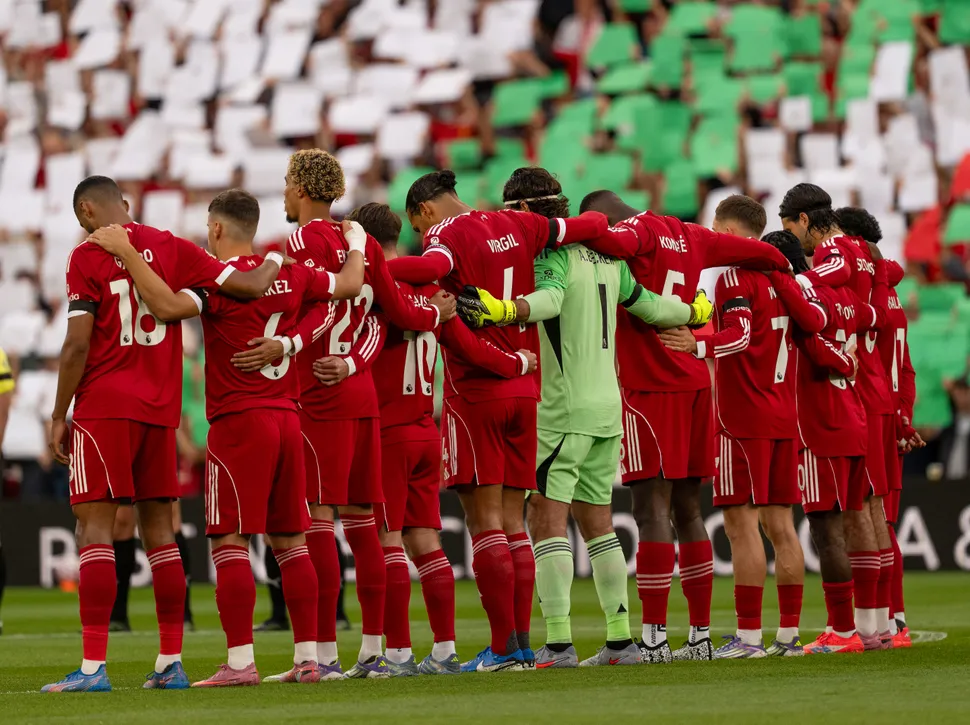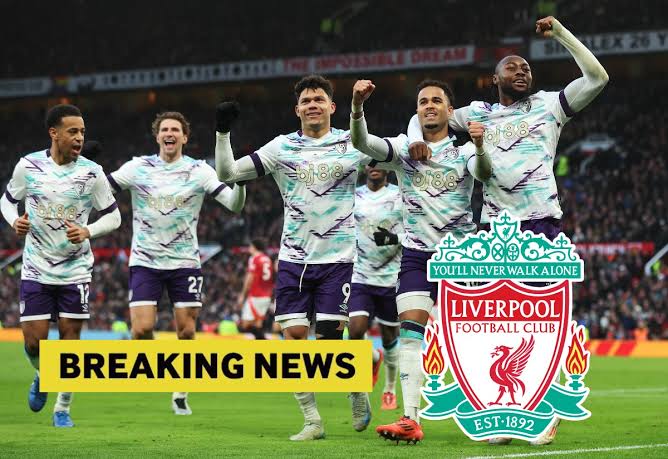Liverpool’s Defensive Vulnerability: A Tactical Analysis of Fast Break Concessions

In what would prove to be a defining moment of tactical naivety, Liverpool found themselves in an almost incomprehensible defensive position. Despite holding a comfortable 2-1 advantage and with the match seemingly under their control, the Reds had committed eight players into the opposition’s penalty area. This extraordinary attacking commitment, while demonstrative of their relentless pursuit of goals, left vast expanses of space behind their defensive line – space that Antoine Semenyo would exploit with devastating efficiency.
The Bournemouth winger’s opportunity materialized from this tactical overcommitment, as he found himself with the luxury of time and space to embark on what can only be described as a mesmerizing journey. Starting from deep within his own half, Semenyo began a run that would cover approximately half the length of the Vitality Stadium pitch. This wasn’t merely a sprint; it was a masterclass in counter-attacking football, executed with the precision and composure that separates good players from exceptional ones.
Semenyo’s second goal of the evening represented everything that modern football counter-attacks aspire to achieve. The initial trigger came from Liverpool’s aggressive positioning, which had seen Virgil van Dijk, Ibrahima Konaté, Andrew Robertson, and Trent Alexander-Arnold all pushed high up the field. Adding to this defensive abandonment were the midfield players who had surged forward in support of the attack, creating a scenario where Liverpool’s usual defensive solidity was replaced by gaping vulnerabilities.
The transition from defense to attack was instantaneous. As soon as Bournemouth regained possession, the space behind Liverpool’s high line became apparent to everyone in the stadium except, seemingly, the Liverpool defenders themselves. Semenyo, displaying the kind of game intelligence that has made him such a valuable asset for the Cherries, immediately recognized the opportunity and began his run.
What followed was a textbook example of how to execute a fast break. Semenyo’s first touch was perfect, setting the ball ahead of him just enough to maintain maximum pace while keeping complete control. His second and third touches continued this theme, each one calculated to maintain momentum while positioning himself for what would inevitably come next. The Liverpool defenders, caught completely off guard by the sudden transition, found themselves in the unenviable position of having to recover ground while Semenyo was already at full flight.
The finish itself was a thing of beauty, demonstrating why Semenyo has become such a crucial player for Bournemouth this season. With Liverpool goalkeeper Alisson Becker advancing from his line in a desperate attempt to narrow the angle, Semenyo maintained his composure admirably. The technique required to score from such a position, while running at full speed and with defenders converging, cannot be understated.
His shot placement was exemplary, finding the perfect balance between power and precision. Too much power, and the ball would have sailed over the crossbar; too little, and Alisson would have had time to make the save. Instead, Semenyo found that sweet spot that all strikers dream of, placing the ball with enough velocity to beat the goalkeeper while maintaining the accuracy needed to find the target.
The goal was a testament to hours of training ground preparation and countless repetitions of similar scenarios. In modern football, where margins are incredibly fine and opportunities often fleeting, the ability to execute under such pressure separates professional players from amateurs. Semenyo’s finish was clinical in the truest sense of the word, displaying the kind of ruthless efficiency that Bournemouth have come to rely upon.
Perhaps most damning for Liverpool was the statistical context surrounding these defensive lapses. According to Opta Sports, both goals conceded by Liverpool in this match were classified as ‘fast breaks’ – a designation that refers to goals scored from rapid transitions from defense to attack, typically characterized by the defending team being caught with players out of position.
The truly staggering aspect of this statistic becomes apparent when viewed in the broader context of Liverpool’s defensive record. The two fast break goals conceded in this single match equaled the total number of such goals that Liverpool had conceded throughout the entirety of the previous season. This represents not just a momentary lapse in concentration, but a fundamental departure from the defensive discipline that has been a hallmark of Jürgen Klopp’s tenure at Anfield.
This statistical anomaly raises serious questions about Liverpool’s tactical approach and decision-making processes. The previous season’s record had demonstrated that Liverpool possessed the tactical discipline and positional awareness necessary to prevent such counter-attacking opportunities. Their defensive structure had been sufficiently robust to limit opponents to just two fast break goals across an entire campaign spanning more than fifty matches.
The decision to commit eight players to an attacking phase while holding a one-goal lead speaks to a mentality that prioritizes aggression over prudence. In the modern game, where tactical sophistication has reached unprecedented levels, such positioning represents a calculated risk that clearly backfired. The psychology behind this approach suggests a team confident in their ability to maintain possession and create additional scoring opportunities, but perhaps overly dismissive of their opponent’s counter-attacking threat.
Liverpool’s attacking philosophy under their current tactical system has always emphasized high pressing and aggressive positioning. This approach has yielded tremendous success over recent seasons, with the team’s ability to win the ball high up the field and create immediate scoring opportunities becoming a signature element of their play. However, the inherent risk in such an approach is that when possession is lost, the team can find itself numerically disadvantaged in defensive situations.
The presence of eight players in the opposition box suggests a level of attacking ambition that bordered on recklessness. While such commitment might be justifiable when chasing a game or desperately needing goals, doing so while protecting a lead demonstrates questionable game management. The tactical instruction to commit so many players forward implies either a miscalculation of the game state or an overconfidence in the team’s ability to regain possession quickly.
From Bournemouth’s perspective, Semenyo’s goal represented the perfect execution of a game plan that had clearly been meticulously prepared. The Cherries’ ability to transition from defense to attack with such devastating efficiency suggests hours of tactical preparation focused specifically on exploiting Liverpool’s high defensive line and aggressive positioning.
Modern football analysis has reached such sophisticated levels that teams can identify and prepare for specific weaknesses in their opponents’ tactical setup. Bournemouth’s coaching staff would have recognized Liverpool’s tendency to commit large numbers of players forward and would have instructed their players to remain alert for counter-attacking opportunities.
Semenyo’s positioning when the opportunity arose was perfect, demonstrating that this wasn’t a fortuitous accident but rather the result of tactical preparation and positional discipline. His ability to time his run perfectly, maintaining himself onside while positioning to exploit the space behind Liverpool’s defense, speaks to the quality of coaching and tactical understanding within the Bournemouth setup.
This defensive vulnerability exposed against Bournemouth represents more than just an isolated incident; it highlights potential systemic issues within Liverpool’s tactical approach. The willingness to commit so many players forward while holding a lead suggests either a lack of tactical flexibility or an overreliance on attacking solutions to game management situations.
Effective game management requires teams to adjust their approach based on the match situation. When holding a lead, particularly away from home, tactical wisdom suggests maintaining defensive stability while looking for opportunities to extend the advantage. Liverpool’s approach in this instance represented the antithesis of such thinking, prioritizing additional goals over defensive security.
The consequences of this approach extend beyond the immediate result. Opposition teams and their analytical departments will have noted this vulnerability and will undoubtedly look to exploit similar situations in future encounters. In the hyper-analytical world of modern football, such weaknesses are quickly identified and become part of the tactical blueprint that opponents use when preparing to face Liverpool.
Liverpool’s defensive approach has undergone significant evolution over recent seasons. The team’s ability to maintain defensive solidity while implementing an aggressive pressing system had been one of their greatest strengths. The partnership between their center-backs, combined with the disciplined positioning of their midfielders, had previously provided the foundation for their attacking philosophy.
However, the statistics from this Bournemouth encounter suggest a departure from these principles. The commitment of eight players to an attacking phase represents an extreme interpretation of attacking football that goes beyond even Liverpool’s traditionally aggressive approach. This level of attacking commitment is more reminiscent of teams chasing desperately needed goals rather than those managing a lead.
The contrast with their previous season’s defensive record is particularly stark. A team that had demonstrated such defensive discipline over an entire campaign suddenly found themselves conceding two fast break goals in a single match. This suggests either a tactical adjustment that has gone too far or a temporary abandonment of the principles that had previously served them so well.
Semenyo’s goal also serves as a reminder of the devastating effectiveness of well-executed counter-attacks in modern football. The speed of transition from defense to attack, combined with the numerical advantages that such situations can create, makes counter-attacking one of the most potent weapons in football’s tactical arsenal.
The key elements of successful counter-attacking were all present in Semenyo’s goal. The initial trigger came from Liverpool’s overcommitment, creating the space necessary for the counter-attack to develop. The speed of execution was crucial, with Semenyo immediately recognizing the opportunity and beginning his run without hesitation. The technical execution was flawless, with each touch designed to maintain maximum pace while keeping the ball under control.
Perhaps most importantly, the finish demonstrated the clinical mentality required to capitalize on such opportunities. Counter-attacks often create high-pressure situations where players must execute technical skills while running at full pace and with limited time to make decisions. Semenyo’s ability to remain composed and execute the finish with such precision exemplifies the highest standards of professional football.
The tactical lessons from this encounter are numerous and significant. For Liverpool, the most obvious lesson concerns the need for better balance between attacking ambition and defensive responsibility. While their attacking philosophy has been central to their success, the extreme interpretation demonstrated in this match proved counterproductive.
Game management represents another crucial area for improvement. The decision to commit so many players forward while protecting a lead suggests a need for better tactical flexibility and situational awareness. Elite teams must be capable of adjusting their approach based on match circumstances, and Liverpool’s failure to do so in this instance cost them dearly.
For Bournemouth, the encounter demonstrated the value of tactical preparation and disciplined execution. Their ability to identify and exploit Liverpool’s weakness while maintaining their own defensive shape provided a blueprint for how smaller clubs can compete with elite opposition.
While tactical analysis provides the framework for understanding this goal, it would be remiss not to acknowledge the individual brilliance that Semenyo displayed. His ability to recognize the opportunity, execute the run with perfect timing, and finish with such clinical precision elevated what could have been merely a tactical exploitation into a moment of genuine quality.
The physical demands of such a run cannot be understated. Covering half the length of a football pitch at maximum pace while maintaining ball control and preparing for a high-pressure finish requires exceptional physical conditioning and mental fortitude. Semenyo’s ability to maintain his technique and composure throughout this sequence speaks to his quality as a professional athlete.
Moreover, his positioning when the opportunity arose demonstrated excellent game intelligence. Many players in similar situations might have been caught flat-footed or positioned poorly to exploit such chances. Semenyo’s awareness and anticipation allowed him to maximize the tactical advantage created by Liverpool’s overcommitment.
This single moment encapsulated many of the key themes that define modern football. The extreme tactical approaches that teams now employ in search of marginal advantages, the sophisticated analytical tools that allow teams to identify and exploit weaknesses, and the individual brilliance required to capitalize on fleeting opportunities all converged in Semenyo’s equalizing goal.
For Liverpool, this encounter serves as a stark reminder that tactical sophistication must be balanced with situational awareness and defensive responsibility. Their previous season’s defensive record had demonstrated their capability in this regard, making their lapses in this match all the more concerning.
The broader implications extend beyond this single match or even this season. In an era where tactical margins are increasingly fine and analytical preparation increasingly sophisticated, such defensive vulnerabilities can quickly become systematic weaknesses that opponents look to exploit.
Semenyo’s expertly taken goal, born from Liverpool’s tactical overcommitment, represents both a moment of individual brilliance and a cautionary tale about the risks inherent in modern football’s tactical extremes. As teams continue to push the boundaries of attacking ambition, the need for tactical balance and defensive discipline becomes ever more crucial. Liverpool’s experience in this match provides a perfect case study in how quickly tactical advantages can become defensive vulnerabilities when situational awareness is abandoned in favor of attacking excess.














